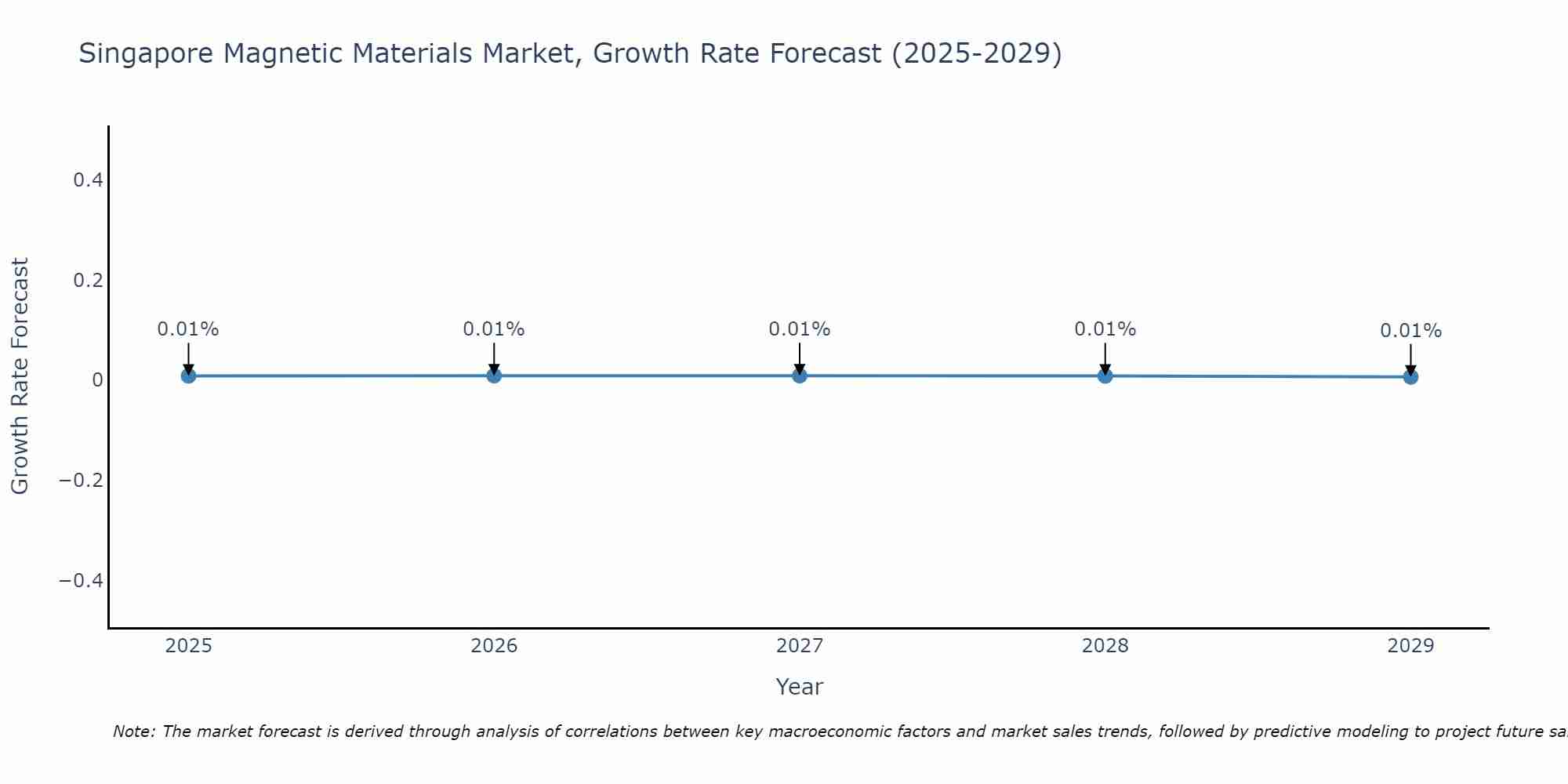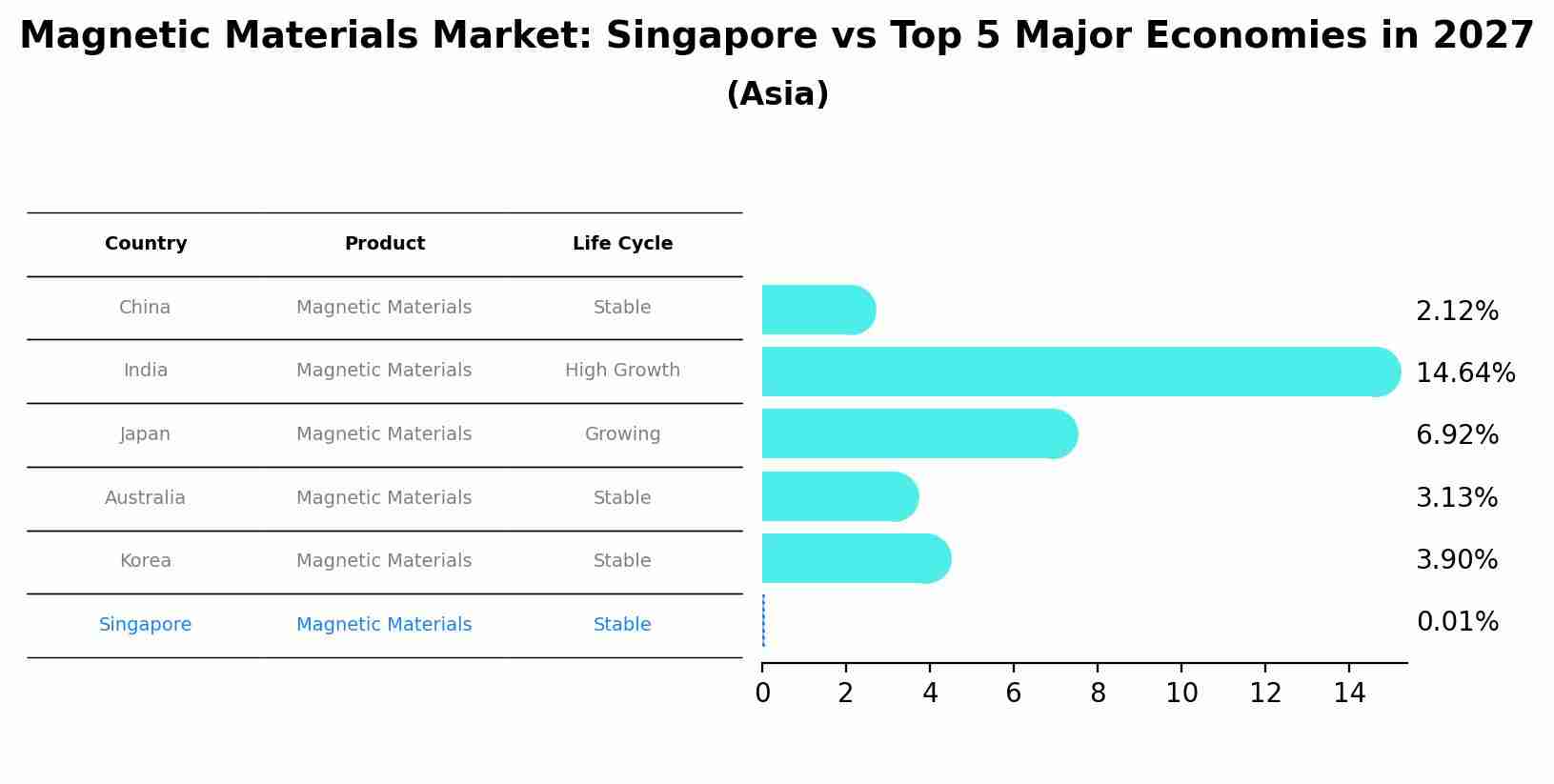Singapore Magnetic Materials Market (2024-2030) | Size, Outlook, Value, Analysis, Trends, Share, Revenue, Growth, Forecast, Companies & Industry
| Product Code: ETC008987 | Publication Date: Jul 2023 | Updated Date: Apr 2025 | Product Type: Report | |
| Publisher: 6Wresearch | No. of Pages: 70 | No. of Figures: 35 | No. of Tables: 5 | |
Singapore Magnetic Materials Market Size Growth Rate
The Singapore Magnetic Materials Market is projected to witness mixed growth rate patterns during 2025 to 2029. Starting at 0.01% in 2025, the market peaks at 0.01% in 2027, and settles at 0.01% by 2029.

Magnetic Materials Market: Singapore vs Top 5 Major Economies in 2027 (Asia)
By 2027, the Magnetic Materials market in Singapore is anticipated to reach a growth rate of 0.01%, as part of an increasingly competitive Asia region, where China remains at the forefront, supported by India, Japan, Australia and South Korea, driving innovations and market adoption across sectors.

Singapore Magnetic Materials Market Synopsis
The Singapore magnetic materials market is expected to grow at a CAGR of 4.3% during the forecast period 2020-2026. The growing consumer electronics industry, increasing adoption of automation technology in various industries, and rising investments in R&D activities are some of the major factors driving the growth of this market. Furthermore, advancements in technology and government initiatives for innovation will drive the demand for magnetic materials over the forecast period.
Market Drivers
Increasing Adoption Of Automation Technology: Automation technology has been increasingly adopted by several manufacturing companies across various sectors such as automotive, electrical & electronics ETC, due to its numerous advantages such as improved efficiency and quality control leading to cost savings. This has led to an increase in demand for specialized permanent magnets used in different types of automation equipment which is likely to boost the growth of this market during the forecast period.Growing Consumer Electronics Industry: The global consumer electronics industry has grown significantly due to rapid urbanization coupled with rising disposable income among consumers worldwide. This increased demand has resulted into greater need for electronic components like semi-conductors, sensors and other integrated circuits that require usage magnetics material resulting into higher product launch activities thereby boosting overall Magnetic Materials Market Growth.
Market challenges
Fluctuating Prices Of Raw Materials : Fluctuations In prices of raw materials used for manufacturing Magnets might act as a restraining factor on market growth rate over near future.Unstability in prices causes manufacturers difficulty while planning their production capacities thus hampering Overall Magnetics Materials Market Development.
Key players
Some key players operating in Singapore Magnetic Materials Market Include Tengam Engineering Pte Ltd, Starlite Global Industries Pte Ltd, MSL Solutions Pte Ltd (Singapore), Applied Magnets Co Pte Ltd (Singapore) among others.
Covid-19 Impact
The Covid-19 pandemic had a major impact on multiple industries including construction, automotive, aviation ETCThese industries use Magntic Material Components extensively hence its supply chain was also disturbed due considerable restrictions imposed by governments on cross country movements during lockdowns.However recovery from these losses have already started taking place thanks to relaxation measures being implemented throughout past months globally hence making it easier for Magnetic Component Manufacturers To resume full operations soon.
Key Highlights of the Report:
- Singapore Magnetic Materials Market Outlook
- Market Size of Singapore Magnetic Materials Market, 2023
- Forecast of Singapore Magnetic Materials Market, 2030
- Historical Data and Forecast of Singapore Magnetic Materials Revenues & Volume for the Period 2020-2030
- Singapore Magnetic Materials Market Trend Evolution
- Singapore Magnetic Materials Market Drivers and Challenges
- Singapore Magnetic Materials Price Trends
- Singapore Magnetic Materials Porter's Five Forces
- Singapore Magnetic Materials Industry Life Cycle
- Historical Data and Forecast of Singapore Magnetic Materials Market Revenues & Volume By Product Types for the Period 2020-2030
- Historical Data and Forecast of Singapore Magnetic Materials Market Revenues & Volume By Semi-hard Magnet for the Period 2020-2030
- Historical Data and Forecast of Singapore Magnetic Materials Market Revenues & Volume By Soft Magnet for the Period 2020-2030
- Historical Data and Forecast of Singapore Magnetic Materials Market Revenues & Volume By Hard Magnet for the Period 2020-2030
- Historical Data and Forecast of Singapore Magnetic Materials Market Revenues & Volume By Applications for the Period 2020-2030
- Historical Data and Forecast of Singapore Magnetic Materials Market Revenues & Volume By Automotive for the Period 2020-2030
- Historical Data and Forecast of Singapore Magnetic Materials Market Revenues & Volume By Electronics for the Period 2020-2030
- Historical Data and Forecast of Singapore Magnetic Materials Market Revenues & Volume By Industrial for the Period 2020-2030
- Historical Data and Forecast of Singapore Magnetic Materials Market Revenues & Volume By Power Generation for the Period 2020-2030
- Historical Data and Forecast of Singapore Magnetic Materials Market Revenues & Volume By Others for the Period 2020-2030
- Singapore Magnetic Materials Import Export Trade Statistics
- Market Opportunity Assessment By Product Types
- Market Opportunity Assessment By Applications
- Singapore Magnetic Materials Top Companies Market Share
- Singapore Magnetic Materials Competitive Benchmarking By Technical and Operational Parameters
- Singapore Magnetic Materials Company Profiles
- Singapore Magnetic Materials Key Strategic Recommendations
Frequently Asked Questions About the Market Study (FAQs):
1 Executive Summary |
2 Introduction |
2.1 Key Highlights of the Report |
2.2 Report Description |
2.3 Market Scope & Segmentation |
2.4 Research Methodology |
2.5 Assumptions |
3 Singapore Magnetic Materials Market Overview |
3.1 Singapore Country Macro Economic Indicators |
3.2 Singapore Magnetic Materials Market Revenues & Volume, 2020 & 2030F |
3.3 Singapore Magnetic Materials Market - Industry Life Cycle |
3.4 Singapore Magnetic Materials Market - Porter's Five Forces |
3.5 Singapore Magnetic Materials Market Revenues & Volume Share, By Product Types, 2020 & 2030F |
3.6 Singapore Magnetic Materials Market Revenues & Volume Share, By Applications, 2020 & 2030F |
4 Singapore Magnetic Materials Market Dynamics |
4.1 Impact Analysis |
4.2 Market Drivers |
4.3 Market Restraints |
5 Singapore Magnetic Materials Market Trends |
6 Singapore Magnetic Materials Market, By Types |
6.1 Singapore Magnetic Materials Market, By Product Types |
6.1.1 Overview and Analysis |
6.1.2 Singapore Magnetic Materials Market Revenues & Volume, By Product Types, 2020-2030F |
6.1.3 Singapore Magnetic Materials Market Revenues & Volume, By Semi-hard Magnet, 2020-2030F |
6.1.4 Singapore Magnetic Materials Market Revenues & Volume, By Soft Magnet, 2020-2030F |
6.1.5 Singapore Magnetic Materials Market Revenues & Volume, By Hard Magnet, 2020-2030F |
6.2 Singapore Magnetic Materials Market, By Applications |
6.2.1 Overview and Analysis |
6.2.2 Singapore Magnetic Materials Market Revenues & Volume, By Automotive, 2020-2030F |
6.2.3 Singapore Magnetic Materials Market Revenues & Volume, By Electronics, 2020-2030F |
6.2.4 Singapore Magnetic Materials Market Revenues & Volume, By Industrial, 2020-2030F |
6.2.5 Singapore Magnetic Materials Market Revenues & Volume, By Power Generation, 2020-2030F |
6.2.6 Singapore Magnetic Materials Market Revenues & Volume, By Others, 2020-2030F |
7 Singapore Magnetic Materials Market Import-Export Trade Statistics |
7.1 Singapore Magnetic Materials Market Export to Major Countries |
7.2 Singapore Magnetic Materials Market Imports from Major Countries |
8 Singapore Magnetic Materials Market Key Performance Indicators |
9 Singapore Magnetic Materials Market - Opportunity Assessment |
9.1 Singapore Magnetic Materials Market Opportunity Assessment, By Product Types, 2020 & 2030F |
9.2 Singapore Magnetic Materials Market Opportunity Assessment, By Applications, 2020 & 2030F |
10 Singapore Magnetic Materials Market - Competitive Landscape |
10.1 Singapore Magnetic Materials Market Revenue Share, By Companies, 2023 |
10.2 Singapore Magnetic Materials Market Competitive Benchmarking, By Operating and Technical Parameters |
11 Company Profiles |
12 Recommendations |
13 Disclaimer |
- Single User License$ 1,995
- Department License$ 2,400
- Site License$ 3,120
- Global License$ 3,795
Search
Related Reports
- Europe Flooring Market (2025-2031) | Outlook, Share, Industry, Trends, Forecast, Companies, Revenue, Size, Analysis, Growth & Value
- Saudi Arabia Manlift Market (2025-2031) | Outlook, Size, Growth, Trends, Companies, Industry, Revenue, Value, Share, Forecast & Analysis
- Uganda Excavator, Crane, and Wheel Loaders Market (2025-2031) | Strategy, Consumer Insights, Analysis, Investment Trends, Opportunities, Growth, Size, Share, Industry, Revenue, Segments, Value, Segmentation, Supply, Forecast, Restraints, Outlook, Competition, Drivers, Trends, Demand, Pricing Analysis, Competitive, Strategic Insights, Companies, Challenges
- Rwanda Excavator, Crane, and Wheel Loaders Market (2025-2031) | Strategy, Consumer Insights, Analysis, Investment Trends, Opportunities, Growth, Size, Share, Industry, Revenue, Segments, Value, Segmentation, Supply, Forecast, Restraints, Outlook, Competition, Drivers, Trends, Demand, Pricing Analysis, Competitive, Strategic Insights, Companies, Challenges
- Kenya Excavator, Crane, and Wheel Loaders Market (2025-2031) | Strategy, Consumer Insights, Analysis, Investment Trends, Opportunities, Growth, Size, Share, Industry, Revenue, Segments, Value, Segmentation, Supply, Forecast, Restraints, Outlook, Competition, Drivers, Trends, Demand, Pricing Analysis, Competitive, Strategic Insights, Companies, Challenges
- Angola Excavator, Crane, and Wheel Loaders Market (2025-2031) | Strategy, Consumer Insights, Analysis, Investment Trends, Opportunities, Growth, Size, Share, Industry, Revenue, Segments, Value, Segmentation, Supply, Forecast, Restraints, Outlook, Competition, Drivers, Trends, Demand, Pricing Analysis, Competitive, Strategic Insights, Companies, Challenges
- Israel Intelligent Transport System Market (2025-2031) | Strategy, Consumer Insights, Analysis, Investment Trends, Opportunities, Growth, Size, Share, Industry, Revenue, Segments, Value, Segmentation, Supply, Forecast, Restraints, Outlook, Competition, Drivers, Trends, Demand, Pricing Analysis, Competitive, Strategic Insights, Companies, Challenges
- Uganda Precast and Aggregate Market (2025-2031) | Strategy, Consumer Insights, Analysis, Investment Trends, Opportunities, Growth, Size, Share, Industry, Revenue, Segments, Value, Segmentation, Supply, Forecast, Restraints, Outlook, Competition, Drivers, Trends, Demand, Pricing Analysis, Competitive, Strategic Insights, Companies, Challenges
- Australia IT Asset Disposal Market (2025-2031) | Strategy, Consumer Insights, Analysis, Investment Trends, Opportunities, Growth, Size, Share, Industry, Revenue, Segments, Value, Segmentation, Supply, Forecast, Restraints, Outlook, Competition, Drivers, Trends, Demand, Pricing Analysis, Competitive, Strategic Insights, Companies, Challenges
- UAE Building Thermal Insulation Market Outlook (2025-2031) | Revenue, Companies, Share, Trends, Growth, Size, Forecast, Industry, Analysis & Value
Industry Events and Analyst Meet
Our Clients
Whitepaper
- Middle East & Africa Commercial Security Market Click here to view more.
- Middle East & Africa Fire Safety Systems & Equipment Market Click here to view more.
- GCC Drone Market Click here to view more.
- Middle East Lighting Fixture Market Click here to view more.
- GCC Physical & Perimeter Security Market Click here to view more.
6WResearch In News
- Doha a strategic location for EV manufacturing hub: IPA Qatar
- Demand for luxury TVs surging in the GCC, says Samsung
- Empowering Growth: The Thriving Journey of Bangladesh’s Cable Industry
- Demand for luxury TVs surging in the GCC, says Samsung
- Video call with a traditional healer? Once unthinkable, it’s now common in South Africa
- Intelligent Buildings To Smooth GCC’s Path To Net Zero













